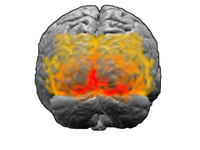
Photo from wikipedia
Abstract Sensory discriminations, such as judgements about visual motion, often benefit from multisensory evidence. Despite many reports of enhanced brain activity during multisensory conditions, it remains unclear which dynamic processes… Click to show full abstract
Abstract Sensory discriminations, such as judgements about visual motion, often benefit from multisensory evidence. Despite many reports of enhanced brain activity during multisensory conditions, it remains unclear which dynamic processes implement the multisensory benefit for an upcoming decision in the human brain. Specifically, it remains difficult to attribute perceptual benefits to specific processes, such as early sensory encoding, the transformation of sensory representations into a motor response, or to more unspecific processes such as attention. We combined an audio‐visual motion discrimination task with the single‐trial mapping of dynamic sensory representations in EEG activity to localize when and where multisensory congruency facilitates perceptual accuracy. Our results show that a congruent sound facilitates the encoding of motion direction in occipital sensory ‐ as opposed to parieto‐frontal ‐ cortices, and facilitates later ‐ as opposed to early (i.e. below 100 ms) ‐ sensory activations. This multisensory enhancement was visible as an earlier rise of motion‐sensitive activity in middle‐occipital regions about 350 ms from stimulus onset, which reflected the better discriminability of motion direction from brain activity and correlated with the perceptual benefit provided by congruent multisensory information. This supports a hierarchical model of multisensory integration in which the enhancement of relevant sensory cortical representations is transformed into a more accurate choice. HighlightsFeature specific multisensory integration occurs in sensory not amodal cortex.Feature specific integration occurs late, i.e. around 350 ms post stimulus onset.Acoustic and visual representations interact in occipital motion regions.
Journal Title: Neuroimage
Year Published: 2017
Link to full text (if available)
Share on Social Media: Sign Up to like & get
recommendations!